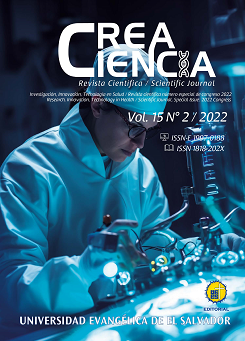Análisis comparativo del desajuste de dos tipos de bases de transferencia para prótesis completa
DOI:
https://doi.org/10.69789/creaciencia.v15i2.660Resumen
Una prótesis completa sirve como reemplazo de dientes y tejidos de soporte,(1), rehabilitando las funciones de masticación, fonación, estética y autoestima del paciente edéntulo (Fig. 1). La confección de prótesis completas (PC) incluye crear bases de transferencia (BT) para evaluarlas antes del procesado definitivo de la PC que el paciente utilizará.(2) El desajuste de las BT de los tejidos bucales implica pérdida de retención y estabilidad, deteriorándose la exactitud de la BT como precursor de la prótesis finalizada (Fig. 2).(3) El objetivo general del estudio fue comparar el desajuste de bases de transferencia construidas con resina acrílica de autopolimerizado (RAAC) y bases de transferencia confeccionadas al vacío con policloruro de vinilo (PVC). Se formularon hipótesis nula (Ho) —que asume igualdad en el desajuste de las BT construidas con RAAC y las de PVC al vacío— e hipótesis de investigación (Hi), que supone que el desajuste de las BT construidas con RAAC (Fig. 3) es diferente al desajuste de las bases confeccionadas con láminas de PVC al vacío (Fig. 4).
Descargas
65
Descargas
Publicado
Cómo citar
Número
Sección
Licencia

Esta obra está bajo una licencia internacional Creative Commons Atribución-NoComercial-CompartirIgual 4.0.
© Crea Ciencia
Declaración de originalidad y cesión de derechos
El artículo debe ser enviado con una declaración de originalidad, responsabilidad y cesión de derechos de copia del manuscrito, escaneada y firmada por el autor o por uno de los autores cuando la autoría es colectiva (autor designado), haciendo constar que el texto no ha sido publicado anteriormente en formato impreso o electrónico, que no se presentará a ningún otro medio antes de conocer la decisión de la revista Crea Ciencia y que, de ser aceptado para su publicación, los autores transfieren los derechos de copia en todas las formas y medios conocidos. Al término de seis meses de la publicación, el texto puede ser compartido en otra revista citando la primera versión del artículo publicado en Crea Ciencia y consignando su número y volumen. En caso de no ser publicado el artículo, la UEES accede a retornar los derechos enunciados a sus autores.

Los artículos de Crea Ciencia están publicados en acceso abierto bajo una licencia de Creative Commons Reconocimiento-NoComercial 4.0 Internacional.

